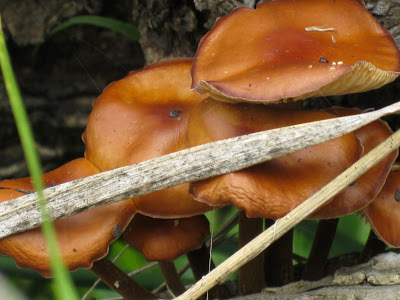Gordon Grice's Blog, page 57
May 5, 2012
Carnivorous Deer
Unusual behavior in a herbivore. Biologists think deer occasionally do this because they need the minerals in the birds' bones. The other birds in the video are mobbing the deer in a futile effort to protect their comrade.
Published on May 05, 2012 02:21
May 4, 2012
Hunter Attacked by Kodiak Bear
 Aaron Logan/Creative Commons
Aaron Logan/Creative CommonsA Kodiak bear knocked a man down a hill and bit him on the head after he shot a different bear. The man stopped to skin the first bear before he left.
Kodiak bear attack may have been defense of cubs: AP Alaska | Alaska news at adn.com:
"Moretz, accompanied by his 13-year-old son, had shot a 9-foot male brown bear in tundra and alder.
They were approaching the dead animal when they walked past a bear den about 100 yards from the kill. A second brown bear emerged suddenly from the den and charged the elder hunter."
Published on May 04, 2012 03:00
May 3, 2012
Alligator Attacks Golfer
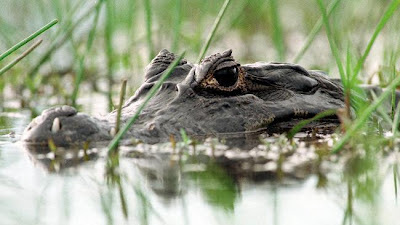
It's been claimed golf is merely men in ugly pants walking. Turns out there's more to it:
Gator attacks golfer in water trap | Herald Sun:
"The alligator launched itself out of the water and sank its teeth into Mr Miller's left knee. His friends rushed to his aid and clung on to his arms as the animal thrashed wildly and attempted to pull him into the water.
"He let me go. I was three feet from my life. He had me submerged up to my belt buckle. That was my miracle of the month," Mr Miller said.
The senior citizen required 40 stitches to close a 25cm cut and two other wounds.
"He just filleted me. You could see into the bone.""
Published on May 03, 2012 02:00
Alligator Attackers Golfer

It's been claimed golf is merely men in ugly pants walking. Turns out there's more to it:
Gator attacks golfer in water trap | Herald Sun:
"The alligator launched itself out of the water and sank its teeth into Mr Miller's left knee. His friends rushed to his aid and clung on to his arms as the animal thrashed wildly and attempted to pull him into the water.
"He let me go. I was three feet from my life. He had me submerged up to my belt buckle. That was my miracle of the month," Mr Miller said.
The senior citizen required 40 stitches to close a 25cm cut and two other wounds.
"He just filleted me. You could see into the bone.""
Published on May 03, 2012 02:00
May 2, 2012
The Mad Love of Black Widow Spiders
Principal photography by Hodari Nundu. Music by Incorporal Air.
Published on May 02, 2012 02:30
May 1, 2012
Pandora Sphinx
Here's a caterpillar of the Pandora sphinx, which eats grapes and virginia creeper before transforming into a fleshy grayish moth with a four-inch wingspan. Photography by D'Arcy Allison-Teasley.
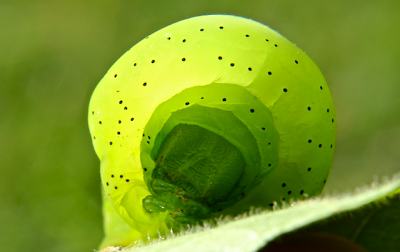
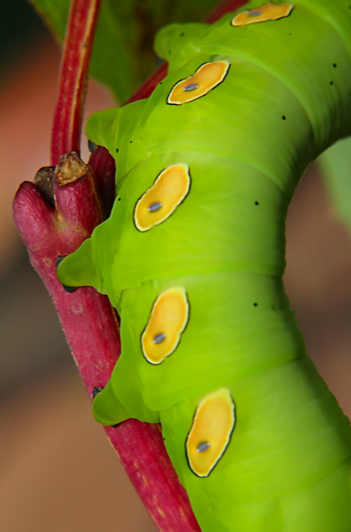

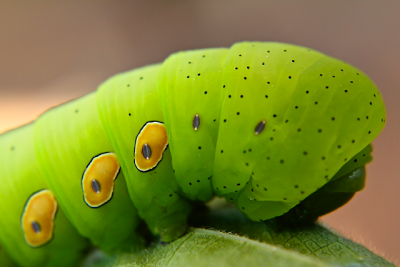
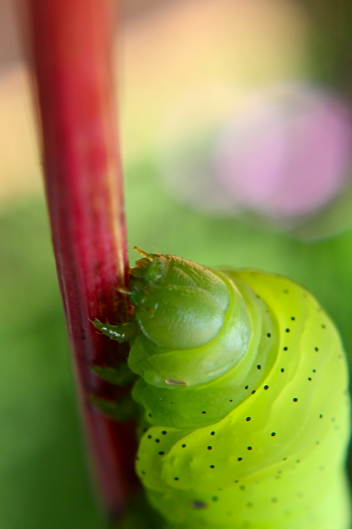








Published on May 01, 2012 09:00
April 30, 2012
Binturong Attacks Keeper
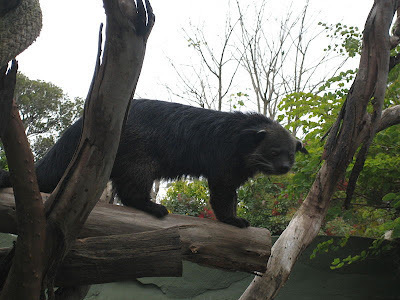 Sheila Allen/Creative Commons
Sheila Allen/Creative CommonsBelow is a muckraking news report about a woman attacked by a captive binturong, or bearcat. The binturong is yet another animal unlikely to ever hurt a person except in captivity. I'm assuming a lot of readers have never heard of this animal, so here's the lowdown:
Closest relatives: The civets...which probably doesn't tell you much. These form one of the more primitive lines of the carnivorids.
Size: A couple of feet long; usually not over 25 pounds. An average specimen is about like a housecat, a big one comparable to a big raccoon.
Diet: Mostly herbivorous, though it will take eggs and insects.
Freakiest feature: A prehensile tail, like that of some monkeys.
As a carnivorid, it's equipped with biting gear:
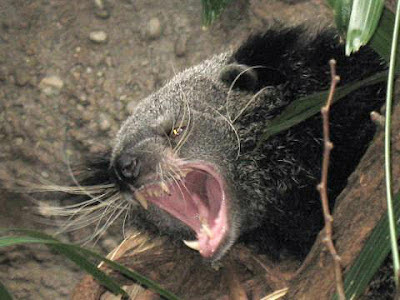
But, as you can see, the teeth are rather fine. It is unlikely to inflict life-threatening wounds.
Bearcat Attacks Worker At Exotic Wildlife Park In Spring: MyFoxHOUSTON.com
Published on April 30, 2012 02:30
April 29, 2012
Mark Twain's Morning

Here, from The Adventures of Tom Sawyer, is another example of Mark Twain's wizardry as a nature writer. It was Mark Dery's new book I Must Not Think Bad Thoughts: Drive-by Essays on American Dread, American Dreams
 that set me off on this tear. Dery admires this particular passage for the "jeweled miniaturism" of its descriptions.
that set me off on this tear. Dery admires this particular passage for the "jeweled miniaturism" of its descriptions.When Tom awoke in the morning, he wondered where he was. He sat up and rubbed his eyes and looked around. Then he comprehended. It was the cool gray dawn, and there was a delicious sense of repose and peace in the deep pervading calm and silence of the woods. Not a leaf stirred; not a sound obtruded upon great Nature's meditation. Beaded dewdrops stood upon the leaves and grasses. A white layer of ashes covered the fire, and a thin blue breath of smoke rose straight into the air. Joe and Huck still slept.
Now, far away in the woods a bird called; another answered; presently the hammering of a woodpecker was heard. Gradually the cool dim gray of the morning whitened, and as gradually sounds multiplied and life manifested itself. The marvel of Nature shaking off sleep and going to work unfolded itself to the musing boy. A little green worm came crawling over a dewy leaf, lifting two-thirds of his body into the air from time to time and "sniffing around," then proceeding again—for he was measuring, Tom said; and when the worm approached him, of its own accord, he sat as still as a stone, with his hopes rising and falling, by turns, as the creature still came toward him or seemed inclined to go elsewhere; and when at last it considered a painful moment with its curved body in the air and then came decisively down upon Tom's leg and began a journey over him, his whole heart was glad—for that meant that he was going to have a new suit of clothes—without the shadow of a doubt a gaudy piratical uniform. Now a procession of ants appeared, from nowhere in particular, and went about their labors; one struggled manfully by with a dead spider five times as big as itself in its arms, and lugged it straight up a tree-trunk. A brown spotted lady-bug climbed the dizzy height of a grass blade, and Tom bent down close to it and said, "Lady-bug, lady-bug, fly away home, your house is on fire, your children's alone," and she took wing and went off to see about it—which did not surprise the boy, for he knew of old that this insect was credulous about conflagrations, and he had practised upon its simplicity more than once. A tumblebug came next, heaving sturdily at its ball, and Tom touched the creature, to see it shut its legs against its body and pretend to be dead. The birds were fairly rioting by this time. A catbird, the Northern mocker, lit in a tree over Tom's head, and trilled out her imitations of her neighbors in a rapture of enjoyment; then a shrill jay swept down, a flash of blue flame, and stopped on a twig almost within the boy's reach, cocked his head to one side and eyed the strangers with a consuming curiosity; a gray squirrel and a big fellow of the "fox" kind came skurrying along, sitting up at intervals to inspect and chatter at the boys, for the wild things had probably never seen a human being before and scarcely knew whether to be afraid or not. All Nature was wide awake and stirring, now; long lances of sunlight pierced down through the dense foliage far and near, and a few butterflies came fluttering upon the scene.
Photo by Parker Grice
Published on April 29, 2012 04:00
April 28, 2012
Fungal Interlude #2
Published on April 28, 2012 09:00
April 27, 2012
Fungi--Killing Stuff, Eating Plastic
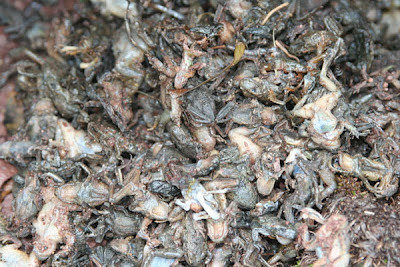 Frogs Killed by Fungi
Frogs Killed by FungiYou may have noticed a lot of news stories over the last couple of years about things dying off because of fungal infections. LiveScience has a roundup of these incidents here.
Fungi are wiping out amphibians on several continents, decimating bats in eastern North America, contributing to the disappearance of bees dubbed colony collapse disorder, and killing corals and sea turtles.
They are even threatening humans, if indirectly, by attacking crops. Fungi and fungilike organisms called oomycetes can cause significant losses to rice, wheat, maize, potatoes and soybeans, according to the researchers who write that the problems "vary regionally but pose a current and growing threat to food security."
These problems are all different, but they may have common roots in habitat disruptions caused by human activities.
Meanwhile, scientists have discovered that some fungi eat plastic. That's good news because discarded plastic is a serious environmental problem.
Published on April 27, 2012 08:30


